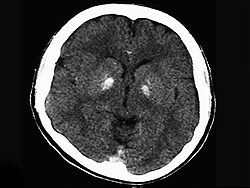- Introduction and Prehospital Care
- Stroke Center Designation/Quality Improvement
- Emergency Evaluation and Diagnosis
- Imaging: Symptoms Unresolved
- Imaging: Symptoms Resolved
- Supportive Care/Addressing Complications (Unchanged)
- Supportive Care/Addressing Complications (Revised)
- Intravenous Fibrinolysis
- Endovascular Interventions
- Anticoagulation
- Antiplatelet Agents
- Volume Expansion, Vasodilators, and Induced Hypertension
- Neuroprotection and Surgery
- Hospital Admission and Treatment
- Treating Neurologic Complications
Introduction and Prehospital Care
On January 31, 2013, the American Heart Association (AHA) and the American Stroke Association (ASA) released new recommendations[1] for the early management of acute stroke, replacing the 2007 guidelines and subsequent 2009 update. The AHA/ASA statement points out that while significant progress has been made in stroke prevention and care -- with stroke falling from the third to the fourth leading cause of death in the United States in 2008 -- the new guidelines are intended to further hone stroke care for physicians, prehospital providers, and other healthcare personnel involved in stroke management. The following summary serves as a quick reference guide to the new guidelines, reviewing both what was unchanged from the previous guidelines as well as what is new or revised.
Prehospital Care
The Basics:
• Stroke education
• 911
• Prehospital assessment tools
• Field management
• Rapid transport to stroke center
• Prehospital notification
The Bottom Line: The prehospital management section focuses on limiting delays and recognizes that interhospital transfers of acute stroke patients for higher-level care are increasingly common.
Unchanged: Physicians and hospital and emergency medical services (EMS) personnel should participate in stroke education programs; 911 services should be used with stroke reports prioritized; and prehospital providers should use diagnostic criteria, such as the Los Angeles Prehospital Stroke Screen or the Cincinnati Prehospital Stroke Scale, and initiate management in the field.
Revised: Patients should be transported to the closest certified primary or comprehensive stroke center or, when such an institution is not available, the closest facility offering emergency stroke care. In some instances, this may involve air medical transport and hospital bypass. Field personnel should notify the receiving facility that a potential stroke patient will be arriving to facilitate resource mobilization.

No comments:
Post a Comment